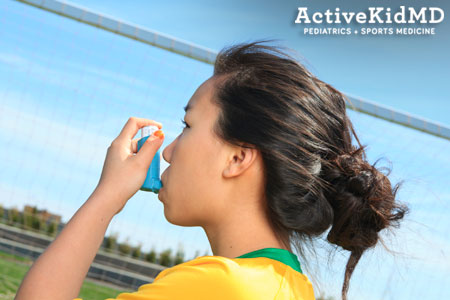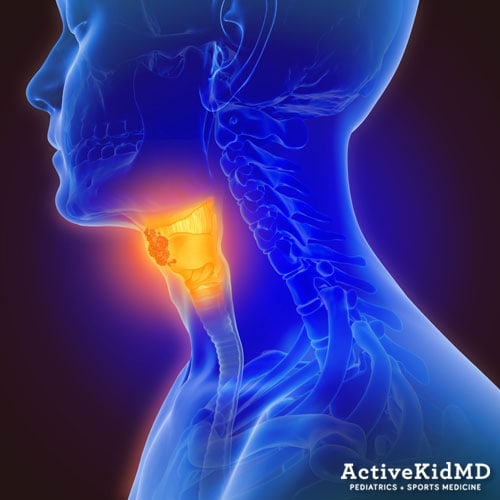Watching your child having trouble breathing with exercise can be a big worry.
You hope that maybe he or she is just out of shape or needs more time to get up to speed.
In the back of your mind, there is that nagging concern about a more serious type of medical problem.
No matter the favorite type of sport or dance, not being able to catch a breath or keep up with others can limit enjoyment and performance.
A lack of conditioning can certainly come into play, especially in a child playing a new sport or starting a new season.
However, if the weeks go on and the breathing doesn’t get easier, it is probably time to think of particular medical issues.
If any of the following conditions appear familiar, or if you have concerns about your child’s ability to breath during exercise, make an appointment with your regular medical provider or a sports medicine specialist.
Heart Problems
Wait a second, isn’t this blog on breathing issues?
Yes, and any discussion of breathing troubles with exercise must consider heart issues, especially in children who report:
- Pain in the chest, particularly on the left side
- Feeling dizzy during exercise
- Feeling a sense of wanting to pass out/faint, or actually passing out/fainting during or after exercise (THIS IS A BIG TIME RED FLAG)
- Heart beating way too fast or appears to jump out of the chest
- Pain that starts in the chest and moves into the left shoulder or arm
- Any past history of heart problems
If there is any concern about heart problems, stop any/all exercise (including practices, rehearsals and performances) and get immediate medical evaluation.
RELATED TOPIC: Sports Physicals including forms with key questions about heart problems in athletes
Exercise Asthma or Bronchospasm

Without a doubt, some type of asthma or airway narrowing is the first thing thought about for trouble breathing or catching breath during exercise.
With asthma or bronchospasm, two things happen that limit the ability of the lungs to move air:
- The medium and small lung airways get narrowed (this is the “bronchospasm”)
- Those medium and small airways get blocked by swelling and inflammation
For a good visual, consider “normal” airways as the size of a toilet paper roll. With asthma or bronchospasm, those airways are first reduced to the size of a straw. That alone can make air movement more difficult. Then fill that straw with pudding or jello and there’s the swelling or inflammation part.
With exercise, the main issues are trouble getting air out of the lungs, chest tightness, and coughing both during and AFTER exercise.
Cooler weather can be a trigger, as can freshly cut grass, days with poor air quality, and even chemicals such as in pools or even exhaust fumes in ice rinks.
If your child has been told they have asthma, then there is a pretty high chance (80-90%) that they will have symptoms with exercise.
I have also seen several patients who had asthma as younger children, but “outgrew” it by elementary school, yet when they hit high school, they have breathing issues with higher demand exercise.
Medical evaluations for possible exercise asthma or bronchospasm may include breathing tests. Sometimes those tests are done on the field or in the dance studio to get a better idea of how the lungs are handling exercise.
Prescription medication can help reduce symptoms. If an “inhaler” is recommended, proper technique and timing can provide the best results. In addition to medication, there are food choices and warm-up techniques that can also help limit asthma or bronchospasm.
RELATED TOPIC: CLICK HERE FOR MORE INFORMATION ON FOOD CHOICES, A UNIQUE WARM-UP, AND PROPER INHALER TECHNIQUE
SOME FINAL TIPS ON EXERCISE ASTHMA AND BRONCHOSPASM
- Yes, coughing up a lung in the locker room or during the car ride home can be exercise asthma or bronchospasm.
- If a child has had asthma in the past, even if it was many years ago, and is now having issues with exercise, get a medical evaluation.
- Not using an inhaler properly can actually make symptoms worse
- Have asthma/bronchospasm and not getting better with a current treatment plan? Get checked out for other conditions that might be going on during exercise.
Vocal Cord Dysfunction (aka Exercise Associated Laryngeal Disorder)
Vocal cord what?

You are not alone. Most people, including medical professionals, aren’t aware of it.
However, if your child is having trouble breathing with exercise, you should definitely be aware of it.
The term VCD not only stands for Vocal Cord Disorder, but also for a Very Confusing Disorder.
During exercise, the vocal cords should open up to allow air movement.
In many athletes and performers, for reasons that aren’t always fully understood, the vocal cords close up and limit air movement in the throat.
Too add to the confusion, symptoms of VCD may appear similar to exercise asthma or bronchospasm. Most of the patients I have seen with VCD had previously been diagnosed with asthma or bronchospasm, and some even have evidence of both disorders.
What makes me think more about VCD?
- Trouble getting air IN
- Tightness in the throat
- Feeling of choking or even near vomiting\
- A weird “whoop” sound with breathing in (that is often can be heard by teammates and coaches)
- Singers who can’t hold notes or keep pitch especially during performances
There are particular medical tests and evaluations that can help diagnose VCD, but in my experience, a careful history is most helpful. I also appreciate reviewing videos from competition, performances or more intense practices.
Treatment for VCD often includes speech therapy and exercises which can often be a game changing or even life changing.
RELATED TOPIC: Vocal Cord Dysfunction: Knowing About It Can Change Your Life!
SOME FINAL TIPS ON VOCAL CORD DYSFUNCTION
- Got asthma but not getting better with treatment, think VCD
- Throat tightness or change in voice
- “Whoop” there it is…VCD
- VCD can be seen with asthma and also with other conditions such as acid reflux (heartburn) and allergies/hay fever
Acid Reflux or Heartburn
That burning desire to win may be reduced by a burning feeling in the airway.
Stomach acid is produced to help digest food, and ideally should stay in the stomach during exercise.
However, in certain sports such as endurance running or cycling, that acid can travel north into the esophagus (swallowing tube), throat, or even the lungs.
Feeling this burn can lead to asthma/bronchospasm (by irritating small lung airways), VCD (by irritating the vocal cords) or a lasting cough/choking sensation.
Adjustments in timing and type of food intake before exercise, breathing techniques, and use of certain medications can reduce the burning feeling.
Recent Illness with fevers and/or new cough
Appropriate levels of exercise can actually reduce the risk of illness.
However, no one is fully immune to getting sick.
Leading up to big competitions and shows, it is common for athletes and performers to inconveniently get sick.
Illnesses with fevers, chills, and new coughs that lead to trouble breathing can be more than just a big inconvenience. They can also be a more serious threat to overall health.
Those symptoms could be from infections such as pneumonia, myocarditis, and other conditions that can affect the heart and lungs.
Other signs of concern include feeling really tired (even when resting), whole body aches, and vomiting/diarrhea.
Don’t take any chances with your sick athlete and performer that has new-onset trouble breathing. Have them immediately evaluated by a medical provider.
RELATED TOPIC: Exercising when sick, how to make the best call


